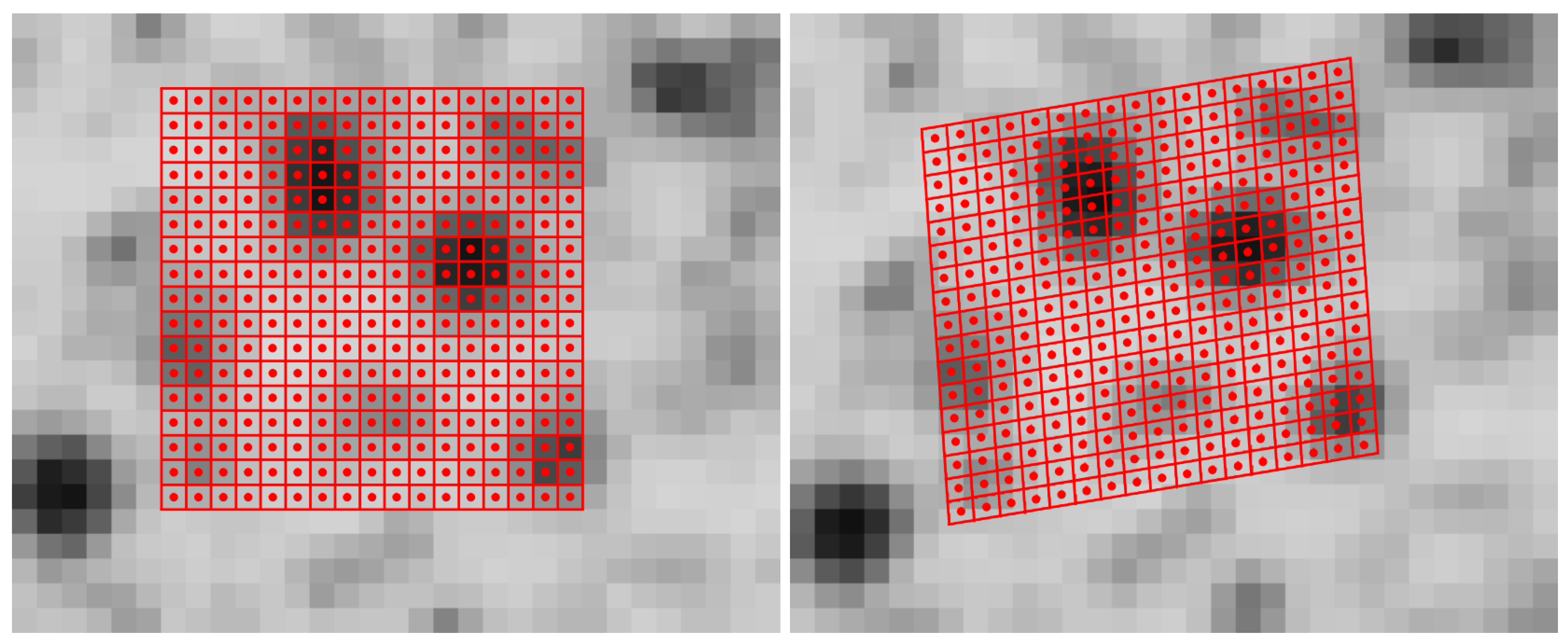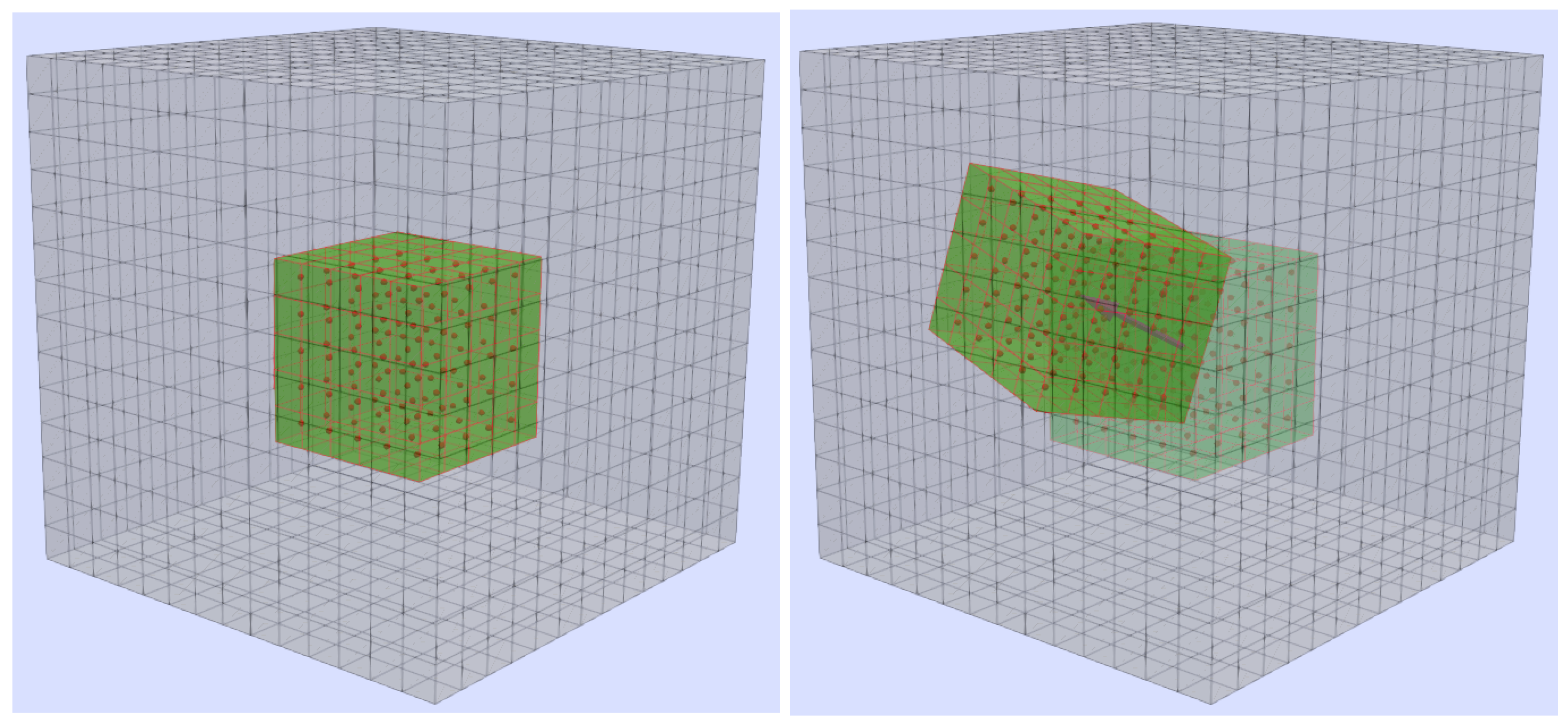Computational Optimization of the 3D Least-Squares Matching Algorithm by Direct Calculation of Normal Equations
Abstract
:1. Introduction
2. 3D Least-Squares Matching
2.1. Mathematical Model
- A = Jacobian matrix
- l = reduced observation vector
- v = residual vector
- s0 = standard deviation of the unit weight
- n = number of voxel of the cuboid
- n = number of unknowns
2.2. Initial Values
2.3. Direct Computation of the Normal Equations
2.4. Computational Effort
2.4.1. Computational Costs of the Direct Method
2.4.2. Computational Costs of the Standard Method
- Multiplications per voxel:
- −
- One multiplication for building up the reduced observation vector .
- −
- Three multiplications for the terms of Equation (33) that are computed temporally due to multiple use for building up the Jacobian matrix.
- −
- Nine further multiplications for building up the Jacobian matrix of Equation (34).
- −
- 105 multiplications (105 elements) due to the matrix multiplication of (only upper triangular matrix).
- −
- 14 multiplications (14 elements) due to the matrix-vector multiplication of .
- Additions per voxel:
- −
- Two additions for building up the reduced observation vector .
- −
- 105 additions (105 elements) due to the matrix multiplication of (only upper triangular matrix).
- −
- 14 additions (14 elements) due to the matrix-vector multiplication of .
2.4.3. Theoretical Comparison
2.4.4. Comparison of Time Measurements in Practise
3. Conclusions
Author Contributions
Funding
Institutional Review Board Statement
Informed Consent Statement
Data Availability Statement
Acknowledgments
Conflicts of Interest
Abbreviations
| LSM | least-squares matching |
| vx | voxel |
| DVC | digital volume correlation |
| SHCC | strain-hardening cement-based composites |
| FFT | Fast Fourier Transform |
Appendix A. Optimized 3D Cross-Correlation
- The values of are computed for the whole search area using the 3D Fast Fourier transform as also done by Lewis [19] for 2D and Yang et al. [14] for 3D: where are the complex conjugate values (∘: Hadamard product, element-wise multiplication). is a volume data set with the same size as the search volume containing t and is filled up with zeros for indices exceeding the dimensions of t.
- The values of and are computed using the integral volume method [20].
Appendix B. 3D Least-Squares Matching with Fixed Radiometric Parameters
Appendix B.1. Mathematical Model
Appendix B.2. Computational Effort
Appendix B.2.1. Direct Method
- Multiplications per voxel:
- −
- Ten multiplications for the temporally terms of Equation (A12).
- −
- 60 multiplications in the matrices.
- −
- 12 multiplications in the sums of .
- Additions per voxel:
- −
- Two additions (subtractions) in .
- −
- 60 additions in the 60 sums of the matrices.
- −
- 12 additions in the 12 sums of .
Appendix B.2.2. Standard Method
- Multiplications per voxel:
- −
- One multiplication for building up the reduced observation vector .
- −
- Three multiplications for the terms of Equation (33) that are computed temporally due to multiple use for building up the Jacobian matrix.
- −
- Nine further multiplications for building up the Jacobian matrix of Equation (34).
- −
- 78 multiplications (78 elements) due to the matrix multiplication of (only upper triangular matrix).
- −
- 12 multiplications (12 elements) due to the matrix-vector multiplication of .
- Additions per voxel:
- −
- Two additions (subtractions) for building up the reduced observation vector .
- −
- 78 additions (78 elements) due to the matrix multiplication of (only upper triangular matrix).
- −
- 12 additions (12 elements) due to the matrix-vector multiplication of .
Appendix B.2.3. Comparison
| Method | Multiplications per vx | Additions per vx |
|---|---|---|
| Standard | 103 | 92 |
| Direct | 82 | 74 |
Appendix C. 3D Least-Squares Matching with 12-Parameter Affine Transformation
Appendix C.1. Mathematical Model
Appendix C.2. Computational Effort
Appendix C.2.1. Direct Method
- Multiplications per voxel:
- −
- Nine multiplications for the temporally terms of Equation (A22).
- −
- 60 multiplications in the matrices.
- −
- 12 multiplications in the sums of .
- Additions per voxel:
- −
- One addition (subtraction) in .
- −
- 60 additions in the 60 sums of the matrices.
- −
- 12 additions in the 12 sums of .
Appendix C.2.2. Standard Method
- Multiplications per voxel:
- −
- Nine multiplications for building up the Jacobian matrix of Equation (A15).
- −
- 78 multiplications (78 elements) due to the matrix multiplication of (only upper triangular matrix).
- −
- 12 multiplications (12 elements) due to the matrix-vector multiplication of .
- Additions per voxel:
- −
- One addition (subtraction) for building up the reduced observation vector .
- −
- 78 additions (78 elements) due to the matrix multiplication of (only upper triangular matrix).
- −
- 12 additions (12 elements) due to the matrix-vector multiplication of .
Appendix C.2.3. Comparison
| Method | Multiplications per vx | Additions per vx |
|---|---|---|
| Standard | 99 | 91 |
| Direct | 81 | 73 |
References
- Barnea, D.I.; Silverman, H.F. A Class of Algorithms for Fast Digital Image Registration. IEEE Trans. Comput. 1972, C-21, 179–186. [Google Scholar] [CrossRef]
- Lucas, B.D.; Kanade, T. An Iterative Image Registration Technique with an Application to Stereo Vision. In Proceedings of the 7th International Joint Conference on Artificial Intelligence, Vancouver, BC, Canada, 24–28 August 1981; Volume 2, pp. 675–679. [Google Scholar] [CrossRef]
- Ackermann, F. Digital Image Correlation: Performance and Potential Application in Photogrammetry. Photogramm. Rec. 1984, 11, 429–439. [Google Scholar] [CrossRef]
- Grün, A. Adaptive least squares correlation: A powerful image matching technique. S. Afr. J. Photogramm. Remote Sens. Cartogr. 1985, 14, 175–187. [Google Scholar]
- Bethmann, F.; Luhmann, T. Least-squares matching with advanced geometric transformation models. Int. Arch. Photogramm. Remote Sens. Spat. Inf. Sci. 2010, 38 Pt 5, 86–91. [Google Scholar]
- Grün, A.; Baltsavias, E.P. Geometrically constrained multiphoto matching. Photogramm. Eng. Remote Sens. 1988, 54, 633–641. [Google Scholar]
- Wrobel, B.P. Digital image matching by facets using object space models. In Advances in Image Processing; Oosterlinck, A.J., Tescher, A.G., Eds.; International Society for Optics and Photonics (SPIE): Bellingham, WA, USA, 1987; Volume 804, pp. 325–335. [Google Scholar] [CrossRef]
- Ebner, H.; Heipke, C. Integration of digital image matching and object surface reconstruction. Int. Arch. Photogramm. Remote Sens. Spat. Inf. Sci. 1988, XXVII, 534–545. [Google Scholar]
- Maas, H.G.; Stefanidis, A.; Grün, A. From pixels to voxels: Tracking volume elements in sequences of 3D digital images. Int. Arch. Photogramm. Remote Sens. Spat. Inf. Sci. 1994, 2357, 539–546. [Google Scholar] [CrossRef]
- Bay, B.K.; Smith, T.S.; Fyhrie, D.P.; Saad, M. Digital Volume Correlation: Three-dimensional Strain Mapping Using X-ray Tomography. Exp. Mech. 1999, 39, 217–226. [Google Scholar] [CrossRef]
- Liebold, F.; Lorenzoni, R.; Curosu, I.; Léonard, F.; Mechtcherine, V.; Paciornik, S.; Maas, H.G. 3D least squares matching applied to micro-tomography data. Int. Arch. Photogramm. Remote Sens. Spat. Inf. Sci. 2021, 43, 533–539. [Google Scholar] [CrossRef]
- Tudisco, E.; Andò, E.; Cailletaud, R.; Hall, S.A. TomoWarp2: A local digital volume correlation code. SoftwareX 2017, 6, 267–270. [Google Scholar] [CrossRef]
- Stamati, O.; Andò, E.; Roubin, E.; Cailletaud, R.; Wiebicke, M.; Pinzon, G.; Couture, C.; Hurley, R.C.; Caulk, R.; Caillerie, D.; et al. spam: Software for Practical Analysis of Materials. J. Open Source Softw. 2020, 5, 2286. [Google Scholar] [CrossRef]
- Yang, J.; Hazlett, L.; Landauer, A.K.; Franck, C. Augmented Lagrangian Digital Volume Correlation (ALDVC). Exp. Mech. 2020, 60, 1205–1223. [Google Scholar] [CrossRef]
- Sutton, M.A.; Orteu, J.J.; Schreier, H. Image Correlation for Shape, Motion and Deformation Measurements: Basic Concepts, Theory and Applications, 1st ed.; Springer: Berlin/Heidelberg, Germany, 2009. [Google Scholar] [CrossRef]
- Jin, H.; Favaro, P.; Soatto, S. Real-Time Feature Tracking and Outlier Rejection with Changes in Illumination. In Proceedings of the Eighth IEEE International Conference on Computer Vision (ICCV), Vancouver, BC, Canada, 7–14 July 2001; Volume 1, pp. 684–689. [Google Scholar] [CrossRef]
- Keys, R. Cubic Convolution Interpolation for Digital Image Processing. IEEE Trans. Acoust. Speech Signal Process. 1981, 29, 1153–1160. [Google Scholar] [CrossRef] [Green Version]
- Lorenzoni, R.; Curosu, I.; Léonard, F.; Paciornik, S.; Mechtcherine, V.; Silva, F.A.; Bruno, G. Combined mechanical and 3D-microstructural analysis of strain-hardening cement-based composites (SHCC) by in-situ X-ray microtomography. Cem. Concr. Res. 2020, 136, 106139. [Google Scholar] [CrossRef]
- Lewis, J.P. Fast Template Matching. In Proceedings of the Vision Interface Conference, Quebec City, QC, Canada, 15–19 May 1995; Volume 95, pp. 120–123. [Google Scholar]
- Urschler, M.; Bornik, A.; Donoser, M. Memory Efficient 3D Integral Volumes. In Proceedings of the 2013 IEEE International Conference on Computer Vision Workshops, Sydney, Australia, 2–8 December 2013; pp. 722–729. [Google Scholar] [CrossRef] [Green Version]


| Method | Multiplications per vx | Additions per vx |
|---|---|---|
| Standard | 132 | 121 |
| Direct | 95 | 100 |
| Mode 1 | M1 | M2 | M3 | M4 |
|---|---|---|---|---|
| Computation time [s] | 12.8 | 23.2 | 19.3 | 17.5 |
Publisher’s Note: MDPI stays neutral with regard to jurisdictional claims in published maps and institutional affiliations. |
© 2022 by the authors. Licensee MDPI, Basel, Switzerland. This article is an open access article distributed under the terms and conditions of the Creative Commons Attribution (CC BY) license (https://creativecommons.org/licenses/by/4.0/).
Share and Cite
Liebold, F.; Maas, H.-G. Computational Optimization of the 3D Least-Squares Matching Algorithm by Direct Calculation of Normal Equations. Tomography 2022, 8, 760-777. https://doi.org/10.3390/tomography8020063
Liebold F, Maas H-G. Computational Optimization of the 3D Least-Squares Matching Algorithm by Direct Calculation of Normal Equations. Tomography. 2022; 8(2):760-777. https://doi.org/10.3390/tomography8020063
Chicago/Turabian StyleLiebold, Frank, and Hans-Gerd Maas. 2022. "Computational Optimization of the 3D Least-Squares Matching Algorithm by Direct Calculation of Normal Equations" Tomography 8, no. 2: 760-777. https://doi.org/10.3390/tomography8020063
APA StyleLiebold, F., & Maas, H.-G. (2022). Computational Optimization of the 3D Least-Squares Matching Algorithm by Direct Calculation of Normal Equations. Tomography, 8(2), 760-777. https://doi.org/10.3390/tomography8020063






